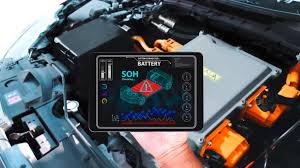Keep Your EV Cool: Advanced Electric Car Cooling Solutions

As an electric vehicle owner, you understand the importance of maintaining your vehicle’s performance and longevity. One crucial aspect of achieving this is by optimizing your electrec car’s cooling system. A well-functioning cooling system ensures that your vehicle’s battery and other critical components operate within a safe temperature range, thereby enhancing overall efficiency and prolonging lifespan.

By optimizing your electric vehicle’s cooling system, you can expect to improve its overall performance, increase its range, and reduce the risk of overheating. In this article, we will delve into the details of how to optimize your electric car’s cooling system, providing you with the knowledge and insights necessary to get the most out of your vehicle.
Key Takeaways
- Understand the importance of optimizing your electric vehicle’s cooling system for peak performance.
- Learn how a well-functioning cooling system can enhance your vehicle’s efficiency and longevity.
- Discover the benefits of optimizing your electric car’s cooling system, including improved performance and reduced risk of overheating.
- Gain insights into the steps necessary to optimize your electric vehicle’s cooling system.
- Maximize your electric vehicle’s range and overall performance.
Understanding Electric Car Cooling Systems
The efficiency of an electric car’s cooling system directly impacts its overall performance and longevity. As you delve into the world of electric vehicles (EVs), understanding how their cooling systems work is essential.
How Electric Vehicle Cooling Differs from Traditional Cars
Electric vehicle cooling systems differ significantly from those in traditional internal combustion engine cars. While traditional cars primarily focus on cooling the engine, EVs need to cool the battery, electric motor, and other critical components. This difference is crucial because the cooling system’s design directly affects the vehicle’s efficiency, range, and overall performance.
Types of Cooling Systems in Modern Electric Vehicles
Modern electric vehicles utilize various cooling systems to maintain optimal operating temperatures.
Liquid Cooling Systems
Liquid cooling systems are widely used in EVs for their effectiveness in heat management. These systems circulate a coolant through the battery pack and other components to absorb and dissipate heat. Liquid cooling is particularly effective for high-performance EVs where heat generation is significant.
Air Cooling Systems
Air cooling systems, on the other hand, use air to cool the vehicle’s components. While less effective than liquid cooling for high-performance applications, air cooling systems are simpler and less costly. They are often used in conjunction with liquid cooling systems or in less demanding EV applications.
Critical Components That Require Cooling
Several critical components in an electric vehicle require effective cooling, including:
- The battery pack, as overheating can reduce its lifespan and efficiency.
- The electric motor, which generates heat during operation.
- Power electronics, such as inverters and converters, which also produce heat.
| Component | Cooling Requirement | Typical Cooling Method |
|---|---|---|
| Battery Pack | High | Liquid Cooling |
| Electric Motor | Medium to High | Liquid or Air Cooling |
| Power Electronics | Medium | Liquid or Air Cooling |

By understanding the cooling system in your electric vehicle, you can better appreciate the technology that goes into maintaining its performance and longevity.
Benefits of Optimized Electric Car Cooling
Electric car owners can reap numerous benefits by ensuring their vehicle’s cooling system is optimized. A well-functioning cooling system is crucial for maintaining the overall health and performance of your electric vehicle.
Extended Battery Life and Performance
Optimizing the cooling system helps in maintaining the battery at an optimal temperature, thereby extending its lifespan and ensuring consistent performance. High temperatures can degrade battery health, so effective cooling is vital.
Improved Charging Efficiency
A cooler battery charges more efficiently than a hotter one. By keeping the battery within an ideal temperature range, you can reduce charging times and improve overall charging efficiency.

Enhanced Driving Range
An optimized cooling system can contribute to an extended driving range. By minimizing energy spent on cooling, more power is available for propulsion, thus enhancing the vehicle’s range.
Reduced Maintenance Costs
Proper cooling reduces the strain on various components, potentially lowering maintenance costs over time. A comparison of maintenance costs with and without optimized cooling is shown below:
| Component | With Optimized Cooling | Without Optimized Cooling |
|---|---|---|
| Battery Replacement | $5,000 (after 8 years) | $5,000 (after 6 years) |
| Cooling System Repairs | $500 (after 5 years) | $1,000 (after 3 years) |
By optimizing your electric car’s cooling system, you can enjoy these benefits, leading to a more efficient and cost-effective ownership experience.
Electric Car Cooling Optimization Techniques
To get the most out of your electric vehicle, it’s essential to understand the various techniques for optimizing its cooling system. Effective cooling optimization can lead to improved performance, extended battery life, and reduced maintenance costs. In this section, we’ll explore the different methods you can use to optimize your electric car’s cooling system.
Software Updates and Their Impact on Thermal Management
Regular software updates can significantly impact your electric car’s thermal management system. Manufacturers often release updates that improve the efficiency of the cooling system, allowing for better performance and longer battery life. It’s crucial to keep your vehicle’s software up-to-date to ensure you’re benefiting from the latest advancements in electric car cooling technology.
Aftermarket Cooling Solutions Worth Considering
In addition to manufacturer-provided solutions, there are various aftermarket cooling solutions available that can enhance your electric car’s cooling performance. These include:
- High-performance cooling fans
- Advanced radiator designs
- Thermal management systems specifically designed for electric vehicles
When considering aftermarket solutions, it’s essential to research and choose products that are compatible with your vehicle and meet your specific needs.
Advanced Thermal Management Settings
Many modern electric vehicles come equipped with advanced thermal management settings that allow you to optimize your car’s cooling system. Two key features to look out for are:
Battery Preconditioning
Battery preconditioning involves adjusting the battery temperature before charging or driving. This can significantly improve the battery’s efficiency and longevity. By preconditioning your battery, you can ensure it’s at the optimal temperature for charging or driving, thereby enhancing overall performance.
Scheduled Charging for Optimal Temperatures
Scheduled charging allows you to charge your vehicle during periods when the ambient temperature is more favorable, typically during off-peak hours. This can help maintain your battery at an optimal temperature, improving its lifespan and efficiency.
Driving Habits That Improve Cooling Efficiency
Your driving habits can also play a significant role in optimizing your electric car’s cooling efficiency. By adopting certain driving practices, you can reduce the strain on your cooling system. Some tips include:
- Avoiding aggressive driving
- Maintaining a consistent speed
- Using regenerative braking effectively
By being mindful of your driving habits, you can contribute to a more efficient cooling system, ultimately enhancing your vehicle’s overall performance and longevity.
Troubleshooting Common Electric Car Cooling Issues
Troubleshooting your electric car’s cooling system can help prevent serious issues down the line. As an electric car owner, it’s essential to be aware of the potential problems that can arise with your vehicle’s cooling system.
Warning Signs of Cooling System Problems
Being able to identify the warning signs of cooling system problems can save you from costly repairs and ensure your electric car’s longevity. Some common indicators include:
- Overheating warnings on your dashboard
- Reduced vehicle performance
- Unusual noises from the cooling system
- Leaks or damage to cooling system components
Temperature Management Challenges in Different Climates
Managing your electric car’s temperature is crucial in various climates. Extreme temperatures can affect your car’s cooling efficiency.
Hot Weather Considerations
In hot weather, it’s essential to monitor your cooling system’s performance closely. Ensure that your car’s cooling system is filled with the correct type and amount of coolant.
Cold Weather Strategies
In cold climates, preheating your car while it’s still plugged in can help reduce the strain on your cooling system. Additionally, using a block heater can be beneficial.
| Climate | Cooling System Considerations |
|---|---|
| Hot | Monitor coolant levels, check for leaks, and ensure proper airflow. |
| Cold | Preheat your car while plugged in, use a block heater if available. |
When to Seek Professional Help
If you notice any unusual signs or symptoms with your electric car’s cooling system, it’s crucial to seek professional help. A certified technician can diagnose and repair issues efficiently, ensuring your car remains in optimal condition.
By being proactive and understanding the common issues related to electric car cooling systems, you can ensure your vehicle operates at its best, providing you with improved electric car cooling efficiency and a longer lifespan.
Conclusion: Future-Proofing Your Electric Vehicle’s Cooling System
As you’ve learned, optimizing your electric car’s cooling system is crucial for maintaining its performance, efficiency, and overall lifespan. By understanding how electric vehicle cooling systems work and implementing optimization techniques, you can enjoy extended battery life, improved charging efficiency, and enhanced driving range.
To future-proof your electric vehicle’s cooling system, stay up-to-date with software updates that can impact thermal management. Consider aftermarket cooling solutions and adjust your driving habits to improve cooling efficiency. Regularly monitoring your electric car cooling performance will help you identify potential issues before they become major problems.
By taking proactive steps to maintain and optimize your electric vehicle cooling system, you can ensure your car continues to run smoothly and efficiently for years to come. This not only enhances your overall driving experience but also contributes to the longevity of your electric car’s battery and other critical components.
FAQ
What is the primary function of an electric car cooling system?
The primary function of an electric car cooling system is to regulate the temperature of the vehicle’s battery, electric motor, and other critical components to ensure optimal performance, efficiency, and longevity.
How does electric vehicle cooling differ from traditional internal combustion engine cooling?
Electric vehicle cooling differs from traditional internal combustion engine cooling in that it focuses on cooling the battery, electric motor, and power electronics, whereas traditional cooling systems focus on cooling the engine. Electric vehicle cooling systems often require more complex thermal management strategies to maintain optimal temperatures.
What are the benefits of optimizing my electric car’s cooling system?
Optimizing your electric car’s cooling system can lead to extended battery life, improved charging efficiency, enhanced driving range, and reduced maintenance costs. Proper cooling can also help prevent overheating, which can cause damage to critical components.
Can aftermarket cooling solutions improve my electric car’s cooling performance?
Yes, aftermarket cooling solutions, such as upgraded radiators, heat exchangers, or cooling fans, can potentially improve your electric car’s cooling performance. However, it’s essential to research and ensure that any aftermarket solution is compatible with your vehicle’s specific cooling system and does not void the manufacturer’s warranty.
How do driving habits affect electric car cooling efficiency?
Driving habits, such as aggressive acceleration, high-speed driving, or frequent stop-and-go traffic, can impact electric car cooling efficiency. Adopting smoother driving habits and avoiding extreme temperatures can help optimize cooling performance.
What are some common warning signs of electric car cooling system problems?
Warning signs of electric car cooling system problems may include dashboard warning lights, unusual noises, or decreased performance. If you notice any unusual temperature fluctuations, leaks, or other issues, it’s crucial to investigate and address the problem promptly to prevent damage to your vehicle’s critical components.
How can I future-proof my electric vehicle’s cooling system?
To future-proof your electric vehicle’s cooling system, stay up-to-date with software updates, monitor your vehicle’s temperature and performance, and address any issues promptly. Regular maintenance, such as checking coolant levels and inspecting the cooling system, can also help ensure optimal performance and longevity.






















































































































































































































































































































